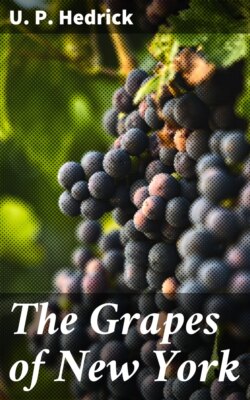Читать книгу The Grapes of New York - U. P. Hedrick - Страница 44
На сайте Литреса книга снята с продажи.
15. VITIS CALIFORNICA Benth.[144]
ОглавлениеTable of Contents
1. Bentham, Bot. Sulph. Voy., 1844:10. 2. Buckley, U. S. Pat. Off. Rpt., 1861:479, 483. California grape. 3. Engelmann, Mo. Ent. Rpt., 1872:62. 4. Ib., Bush. Cat., 1883:10, 11, 12, 14, 15. California grape. 5. Munson, Am. Hort. Soc. Rpt., 1885:137. 6. Planchon, De Candolle’s Mon. Phan., 5:323, 339. 1887. 7. Munson, Soc. Prom. Ag. Sci. Rpt., 1887:59. California grape. 8. Hammond, Gar. and For., 2:39. 1889. Wild grape. 9. Munson, U. S. D. A. Pom. Bul., 3:10. 1890. 10. Ib., Gar. and For., 3:474, 475. 1890. 11. Ib., Mich. Hort. Soc. Rpt., 1893:116. 12. Husmann, 1895:4, 189. 13. Bailey, Gray’s Syn. Fl., 1:426. 1897. 14. Munson, Tex. Sta. Bul., 56:230, 239. 1900. North California grape. 15. Viala and Ravaz, Am. Vines, 1903:42, 50.
Vine vigorous, climbing, but shrubby if left without support; shoots cylindrical or slightly angled; diaphragms of medium thickness to rather thin; tendrils intermittent, bifid or trifid. Leaves with stipules medium to small; leaf broadly cordate; petiolar sinus variable, usually wide and open, usually entire, sometimes slightly tri-lobed; teeth variable in size, blunt; smooth above and varying below from glabrous to much whitish pubescence. Clusters small to medium, usually compact; peduncle mostly long and slender. Berries small, black with rather abundant bloom. Seeds small to medium, plump, slightly notched, if at all; chalaza oblong-oval; raphe slightly distinct or invisible.
Californica was named and described by Bentham in 1844. It was later mentioned by Newberry, Torrey and others. As these descriptions were all made either from herbarium specimens or by botanists traveling through the region, they are not so definite as those made later.
The habitat of Californica is the northern half of California along streams west of the Sierra Nevada mountains and north into Rogue River Valley in southern Oregon, its northern limit.
This species is interesting in that it is a native of a region of North America not originally infested with phylloxera, but in which phylloxera has since been introduced. As might be suspected, it has little more resistance to this insect than Vinifera and less than any other American species. The roots are thick and fleshy, resembling Vinifera. The fruit, while pleasant, is too small to be of cultural value. It is too tender for planting in the open ground where the thermometer drops much below freezing. California growers state that it does not flourish in dry shallow soils. It is very susceptible to attacks of mildew, to which it usually succumbs when planted east of the Rocky Mountains. Californica grows readily from cuttings. It is sometimes used in its native country as an ornamental on account of its highly colored autumn foliage but is otherwise of no value.
